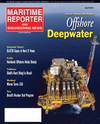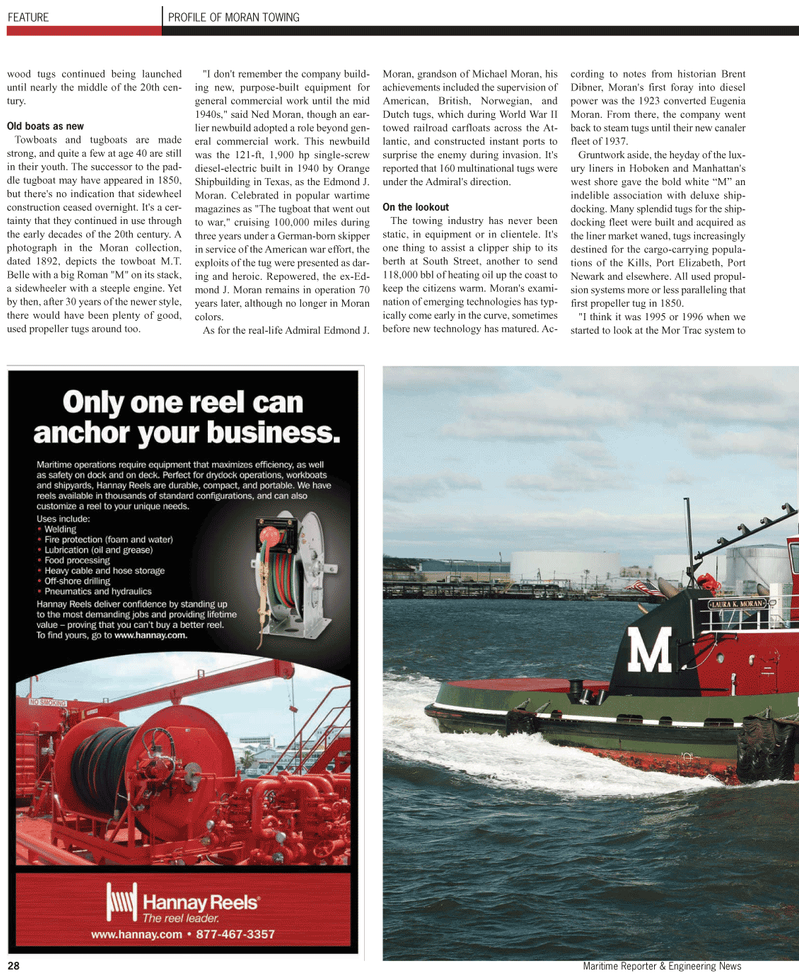
Page 28: of Maritime Reporter Magazine (April 2, 2010)
Read this page in Pdf, Flash or Html5 edition of April 2, 2010 Maritime Reporter Magazine
wood tugs continued being launched until nearly the middle of the 20th cen- tury.
Old boats as new
Towboats and tugboats are made strong, and quite a few at age 40 are still in their youth. The successor to the pad- dle tugboat may have appeared in 1850, but there's no indication that sidewheel construction ceased overnight. It's a cer- tainty that they continued in use through the early decades of the 20th century. A photograph in the Moran collection, dated 1892, depicts the towboat M.T.
Belle with a big Roman "M" on its stack, a sidewheeler with a steeple engine. Yet by then, after 30 years of the newer style, there would have been plenty of good, used propeller tugs around too. "I don't remember the company build- ing new, purpose-built equipment for general commercial work until the mid 1940s," said Ned Moran, though an ear- lier newbuild adopted a role beyond gen- eral commercial work. This newbuild was the 121-ft, 1,900 hp single-screw diesel-electric built in 1940 by Orange
Shipbuilding in Texas, as the Edmond J.
Moran. Celebrated in popular wartime magazines as "The tugboat that went out to war," cruising 100,000 miles during three years under a German-born skipper in service of the American war effort, the exploits of the tug were presented as dar- ing and heroic. Repowered, the ex-Ed- mond J. Moran remains in operation 70 years later, although no longer in Moran colors.
As for the real-life Admiral Edmond J.
Moran, grandson of Michael Moran, his achievements included the supervision of
American, British, Norwegian, and
Dutch tugs, which during World War II towed railroad carfloats across the At- lantic, and constructed instant ports to surprise the enemy during invasion. It's reported that 160 multinational tugs were under the Admiral's direction.
On the lookout
The towing industry has never been static, in equipment or in clientele. It's one thing to assist a clipper ship to its berth at South Street, another to send 118,000 bbl of heating oil up the coast to keep the citizens warm. Moran's exami- nation of emerging technologies has typ- ically come early in the curve, sometimes before new technology has matured. Ac- cording to notes from historian Brent
Dibner, Moran's first foray into diesel power was the 1923 converted Eugenia
Moran. From there, the company went back to steam tugs until their new canaler fleet of 1937.
Gruntwork aside, the heyday of the lux- ury liners in Hoboken and Manhattan's west shore gave the bold white “M” an indelible association with deluxe ship- docking. Many splendid tugs for the ship- docking fleet were built and acquired as the liner market waned, tugs increasingly destined for the cargo-carrying popula- tions of the Kills, Port Elizabeth, Port
Newark and elsewhere. All used propul- sion systems more or less paralleling that first propeller tug in 1850. "I think it was 1995 or 1996 when we started to look at the Mor Trac system to
FEATURE PROFILE OF MORAN TOWING 28 Maritime Reporter & Engineering News

 27
27

 29
29
